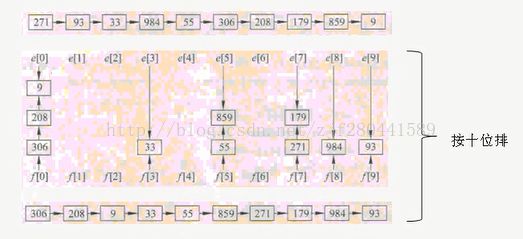基数排序是一种借助“多关键字排序”的思想来实现“单关键字排序”的内部排序算法。
实现多关键字排序通常有两种作法:
最低位优先法(LSD)
先对K[0]{基数的最低位}进行排序,并按 K(0) 的不同值将记录序列分成若干子序列之后,分别对 K[1] 进行排序,..., K[d-1]依次类推,直至最后对最次位关键字排序完成为止。
最高位优先法(MSD)
先对 K[d-1]{基数的最高位}进行排序,然后对 K[d-2]进行排序,依次类推,直至对最主位关键字 K[0] 排序完成为止。
百度百科对基数排序做了如下介绍:
基数排序(radix sort)是属于“分配式排序”(distribution sort),基数排序法又称“桶子法”(bucket sort),顾名思义,它是透过键值的部份资讯,将要排序的元素分配至某些“桶”中,藉以达到排序的作用,基数排序法是属于稳定性的排序,在某些时候,基数排序法的效率高于其它的稳定性排序法。
链式基数排序基本步骤如下
1.将待排序记录以数组存储[或者以指针相链,构成一个链表]
2.”分配”时,按当前”关键字位”所取值,将记录分配到不同的”链表/链队列”(即不同的桶或堆中)中,每条链表中记录的”关键字位”相同;
3.”收集”时,按当前关键字位取值从小到大(即将这n条链表(n的大小为基数的大小)按照编号, 依次将其中所有的元素取出)将各链表中的元素取出放入到原先的数组或链表中;
4.对每个关键字位均重复 2) 和 3) 两步n次。
如采用LSD对{179, 208, 306, 93, 859, 984, 55, 9, 271, 33}(构成一个链表或者是数组)进行基数排序:
[第一步:按个位排]
[第二步:按十位排]
[第三步:按百位排]
代码实现(以LSD为例):
//寻找数组中最大数字的位数
template
unsigned int maxBits(Type *begin, Type *end)
{
unsigned int bits = 1;
//standard作为基准, 如果array中的元素
//大于standard, 则bits+1
int standard = 10;
for (Type *current = begin; current != end; ++current)
{
while (*current >= standard)
{
standard *= 10;
++ bits;
}
}
return bits;
} /**说明:
begin:数组起始
end:数组结尾
radix:基数
*/
#define DEBUG
template
void radixSort(Type *begin, Type *end, int radix)
{
//找到数组中最大数字的位数
int bits = maxBits(begin, end);
//基数为radix, 则需要radix个链表
std::list lists[radix];
// 需要循环bits次
for (int d = 0, factor = 1; d < bits; ++d, factor*=10)
{
//分配...
for (Type *current = begin; current != end; ++current)
{
//取出相应位置上的数 (比如个位是1)
int number = ((*current)/factor)%10;
//则需要将之放到(分配到)标号为1的链表中
lists[number].push_back(*current);
}
//收集...
Type *current = begin;
//对radix个链表中的元素进行收集
for (int i = 0; i < radix; ++i)
{
while (!lists[i].empty())
{
*current = lists[i].front();
++ current;
lists[i].pop_front();
}
}
#ifdef DEBUG
//打印排序的中间结果
for (current = begin; current != end; ++ current)
{
cout << *current << ' ';
}
cout << endl;
#endif // DEBUG
}
}
template
void radixSort(Type *array, int arraySize, int radix)
{
return radixSort(array, array+arraySize, radix);
} 时间复杂度分析:
设待排序列为n个记录,d个关键码,关键码的取值范围为radix,则进行链式基数排序的时间复杂度为O(d(n+radix)),其中,一趟分配时间复杂度为O(n),一趟收集时间复杂度为O(radix),共进行d趟分配和收集.
附-测试代码:
int main()
{
int array[10];
for (int i = 0; i < 10; ++i)
{
array[i] = rand()%1000;
}
for (int i = 0; i < 10; ++i)
{
cout << array[i] << ' ';
}
cout << endl;
radixSort(array, 10, 10);
for (int i = 0; i < 10; ++i)
{
cout << array[i] << ' ';
}
cout << endl;
return 0;
}

